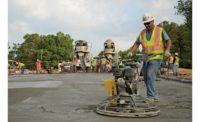The skyscraper-studded Los Angeles skyline is emblematic of the growth and diversification of the city’s enterprises. That growth is paralleled by the story of a residential plaster-and-lath specialty contractor founded in the city 80 years ago that now provides commercial interior and exterior wall construction and theming-finish services for a broad range of project types in the largest markets in California: Los Angeles, the Bay Area and San Diego.
The company started by George Raymond—now known as the Raymond Group—is an 800-employee firm that still is owned and run by the founder’s descendants. And not only has it risen to third in ENR’s national ranking of wall and ceiling specialists, but it also has been selected as ENR California’s Specialty Contractor of the Year.
Raymond’s frequent involvement over the years in many ENR Best Projects reflects the company’s long-standing ability to retain its founder’s values of integrity and quality while embracing new technologies and processes—including building information modeling, integrated project delivery, design-assist, prefabrication and automated site manufacturing—that are required these days for efficiency, growth and success. But while technology facilitates the building process, CEO Travis Winsor says no software or app can substitute for personal relationships in construction.
“Our managers have to know how to interact with project teams, and with each other,” Winsor says, adding that the deep experience of the firm’s managers make them adept at handling the increasing amount of project risk being shifted to contractors and specialty trades. “We’re experienced enough to be watchful for anything that should be addressed, whether it arises in the design development phase or later on,” Winsor says.
Maintaining relationships with a select group of general contractors is likewise part of the company’s strategy. Familiarity and experience with repeat customers also enhances the firm’s ability to adapt to the ebb and flow of market activity across geographic regions and sectors.
“We know what the GCs want and expect to be successful,” Winsor says. “Each one may have a different market focus—commercial, high-rise residential, health care and so forth—but they usually approach each project [within that market] in the same way. So we know how to fit with that approach, no matter what kind of project it is.”
Increasingly, those approaches rely upon Raymond’s design-assist services, the demand for which “is further propelled by the fact that the overall level of design development in plans provided for specialty trade involvement is dropping,” Winsor says. “This creates a greater need for a specialty trade contractor to provide [design-assist] service to integrate with the project team at a much earlier stage, and find ‘win-win’ solutions to construction challenges.”
Jamie Macartney, a project manager with C.W. Driver, agrees with that need for design-assist, and he appreciates Raymond’s track record of meeting that need for general contractors at a time when more and more project plans are being released at 75% completion and owners are increasingly expecting contractors to contribute trade knowledge to help finish designs.
“Raymond has that knowledge,” says Macartney, who is currently working with Raymond on the 925,000-sq-ft Five Lagunas urban village in Orange County. “They’re not reactive. They’re always forward-looking. They know what the issues will be.”
Brendan Murphy, vice president and Southern California operations manager at Turner Construction, for which Raymond is installing framing, drywall and insulation for the soon-to-be-completed $1-billion Wilshire Grand Center in Los Angeles, also praises the company’s “dedication to the project, their ability to think outside the box” and willingness to adjust its own processes to boost project productivity. He says sometimes the improvements have been “dramatic.”
Riding the Waves
What has most helped the company prosper in recent years, according to Winsor, has been applying lessons of its collective experience to manage the post-recession volatility of its disparate construction markets.
For example, the company’s firmwide 2015 revenue topped $188 million, of which California work accounted for $127 million of the total. That’s an overall increase of $43 million from the previous year, yet still off the company’s record $300 million tallied in 2009, when the firm was working on the $9.2-billion City Center complex in Las Vegas.
“We had some big revenue numbers in the 1990s and early 2000s, but we weren’t efficient,” admits Winsor, who was named CEO in 2004, seven years after joining the company as an estimator and project manager. He characterizes the firm’s current pace of growth as “more measured” than in those years and says the company is avoiding the risks of overstaffing by emphasizing efficiency through collaboration across its regional offices.
The Future
Other California projects Raymond has underway include the $943-million, 509,500-sq-ft Jacobs Medical Center in La Jolla for Kitchell Construction; Swinerton Builders’ $228-million third phase of San Francisco’s Trinity Place mixed-use development, which includes a 19-story residential tower; and the expansion of Intuit’s Mountain View headquarters campus for Hathaway Dinwiddie Construction Co.
In Las Vegas, where the company has had a full-service office supporting the city’s entertainment and casino market since 1995, Raymond is working with the PENTA Building Group on Wynn Resorts’ Paradise Park, a $1.5-billion, 1,000-room expansion.
Not surprisingly, Raymond’s prefabrication capabilities are figuring more frequently in its interior and exterior projects, including providing wall panels for the 164,400-sq-ft housing and dining commons at California State University’s San Bernardino campus. The firm currently maintains prefabrication facilities in Southern California and Las Vegas and says it will establish temporary prefabrication facilities near other jobsites when logistical needs warrant.
Prefabrication, Winsor says, “shifts us from field-oriented delivery to manufacturing delivery, which has its own set of challenges and requires more up-front coordination with the project’s designers.” On the other hand, prefabrication also offers coveted efficiencies, including reduced jobsite risk and better use of labor, he says.
“I see the use of prefabrication increasing,” Winsor says. “It will change the way we do things.”
Though Winsor expects the California construction markets to moderate for the near term, the company nevertheless has a busy year ahead, with a project agenda that includes the ongoing 200,000-sq-ft expansion of the Anaheim Convention Center for Turner; the 112,000-sq-ft San Francisco State University Recreation Center for C.W. Driver; and a 144,000-sq-ft Nordstrom store in San Diego’s Westfield UTC retail center for Pacific National Group.
And along with securing new project opportunities, Winsor expects the company to continue refining its current practices and evaluating others that will improve project development and execution. “We’re always looking for ways to be more efficient in the ways we do business,” he says.








